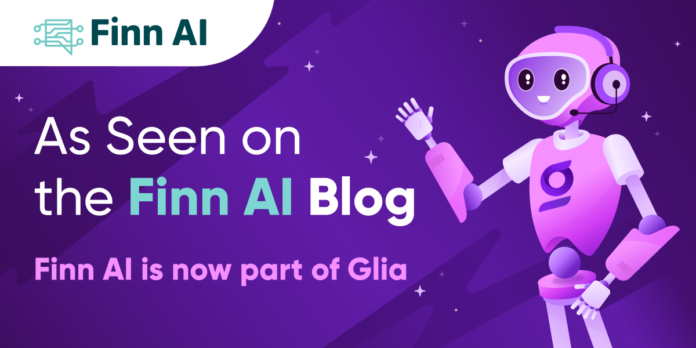This post originally appeared on the Finn AI blog, which is now part of Glia.
Conversational AI in banking—you hear about it at financial services conferences; it’s referenced in just about every industry analyst report; thought leaders are writing about it; and almost every bank is integrating it in some capacity. Rising above the hype, we should stop to ask ourselves, “How can we measure the true impact of AI to our business?” And more importantly, “How is it improving our bottom line?”
We’ve examined five ways conversational AI can deliver solid business results by solving your most strategic problems—acquiring, retaining, growing, and servicing customers, improving the digital banking customer experience, and increasing employee productivity.
1. Conversational AI increases customer lifetime value
Customer Lifetime Value (CLV)—often referred to as Lifetime Value (LTV)—is a metric that represents the value of a customer to your bank over the entire length of your relationship with that customer. Marketers watch this metric carefully as it indicates how much you should invest to acquire and retain different types of customers.
In banking, CLV is often monitored as an annual figure since banks generally retain customers for a long period of time. During the relationship, customers will range from being highly profitable to mildly profitable (or not profitable at all) based on the stage of their life and how they manage their money.
With a banking chatbot, banks can create financial assistants that deliver contextual recommendations to help customers make decisions about which accounts, credit cards, loans, savings, and investment options are right for them at any particular life stage. Through these personalized channels, banks can increase financial literacy, build trust, and, ultimately, sell meaningful products and services along the customer journey to increase their LTV.
“Banks can increase financial literacy, build trust, and, ultimately, sell meaningful products and services along the customer journey to increase their LTV.”
2. Conversational AI reduces customer acquisition costs
Customer acquisition cost (CAC) is the expense involved in identifying, winning, and onboarding a new customer. Reducing CAC is a constant business challenge—especially in an age where the customer experience bar is set so high. Generally, the average CAC across all industries has been rising as it takes more expensive promotions and rewards programs to win customers.
Banking chatbots can drastically reduce customer acquisition costs while also delivering better customer experiences. It uses your data to help you anticipate customer needs and create more personalized marketing campaigns. You can also identify high-value customers that you can target with custom offerings.
Furthermore, customers can receive curated product information and suggestions, creating a more engaging experience. Conversational AI banking reduces customer friction points, making is easier for them to apply for products and services. This increases the speed at which they convert, which in turn makes it more likely that you will acquire them as a customer.
3. Conversational AI increases customer retention
In the past, people joined the same bank that their parents used. Sometimes they’d switch when they started university if they got hooked by a clever marketing campaign. Once they started working however, switching banks became too much of an ordeal.
According to Forrester’s 2017 and 2018 Customer Experience Index, this trend is shifting as the banking industry struggles to create and maintain a human connection with customers. Millennials—a cohort at the peak of financial services usage—are 2 to 3 times more likely to close accounts with their primary financial institution than people in other age groups. In fact, 12 percent of millennials say they would switch banks for as little as a free cup of coffee each month.
Millennials expect great service. By providing them with proactive recommendations and helping them achieve their financial goals, banks can foster financial literacy, trust and well-being, and increase retention. Banking chatbots can help banks do this in a personal way—and at scale.
“Millennials—a cohort at the peak of financial services usage—are 2 to 3 times more likely to close all accounts with their primary financial institution.”
4. Conversational AI decreases customer service costs
A staggering 265 billion customer support requests are made every year costing businesses $1.3 trillion to service them. Conversational AI chatbots are a perfect solution to help deflect and triage repetitive customer support inquiries while also enhancing the customer experience.
When banks upgrade from inefficient (and frustrating) Interactive Voice Response (IVR) technology to a chatbot, their customer service costs reduce by 30 percent. To put this in monetary terms, by 2022, banking interaction costs are expected to decrease by 70 cents per interaction due to AI automation.
With 70 percent of consumers preferring messaging over calling for customer support, conversational AI in banking customer service is a win-win for everyone.
“By 2022, banking interaction costs are expected to decrease by 70 cents per interaction due to AI automation.”
5. Conversational AI makes bank employees more productive
According to the McKinsey Global Institute, over two-thirds of occupations could have 30 percent of their activities automated. This frees up time for humans to spend on more productive tasks i.e. complex problem solving, critical thinking, and creativity (the top three skills deemed essential by the World Economic Forum).
In addition to freeing up time spent on repetitive tasks, chatbots can help eliminate workflow gaps that force human intervention due to disparate processes, systems, and channels. It also reduces or eliminates employee training costs as processes requiring lengthy systems training are enhanced with conversational user interfaces, natural language, and familiar channels anyone can use instantly.
AI employees are the future—smart banks will prepare their workforce to welcome them sooner rather than later. A recent Gartner report predicts that one in five workers will have AI as their coworker in 2022. That’s not so far away.
“One in five workers will have AI as their coworker in 2022.”
This list of efficiencies is not exhaustive—there are many ways conversational AI banking is changing how financial institutions interact with their customers, employees, and partners. And with the ever-changing fintech landscape and advances in machine learning, we expect this list to grow in 2019 and beyond.





